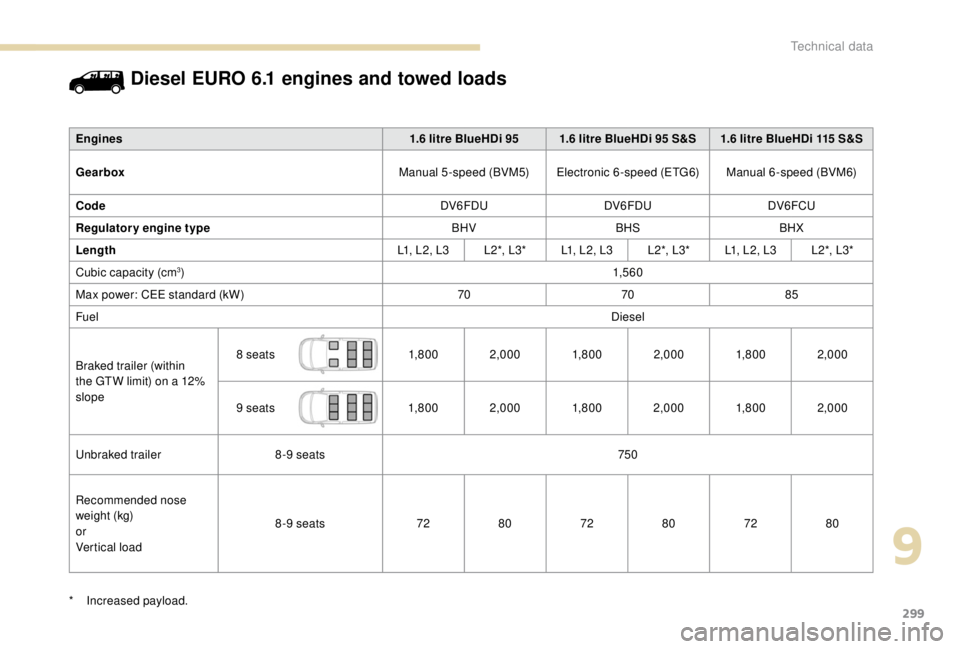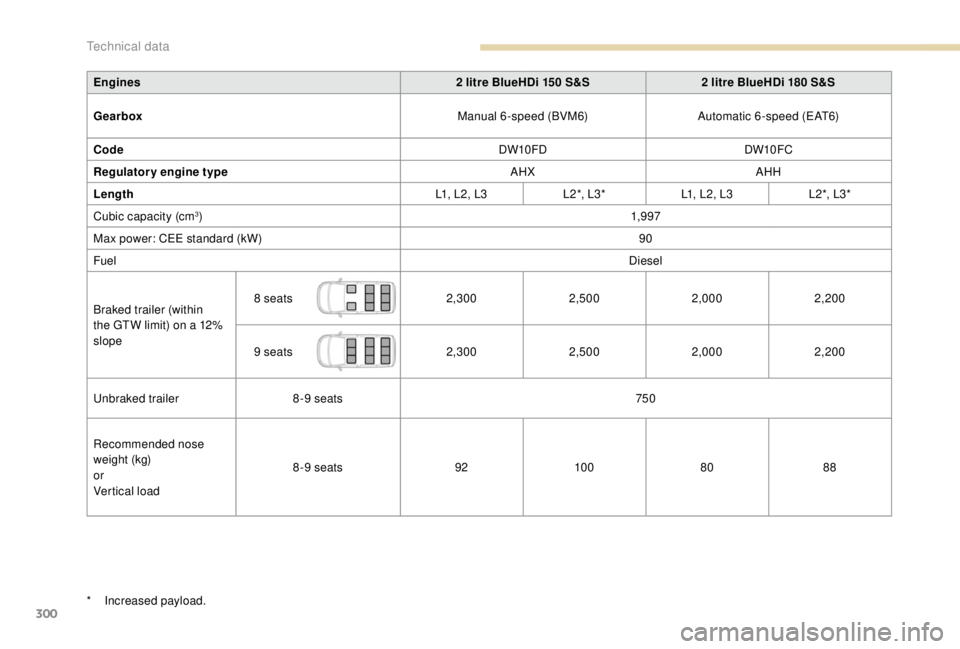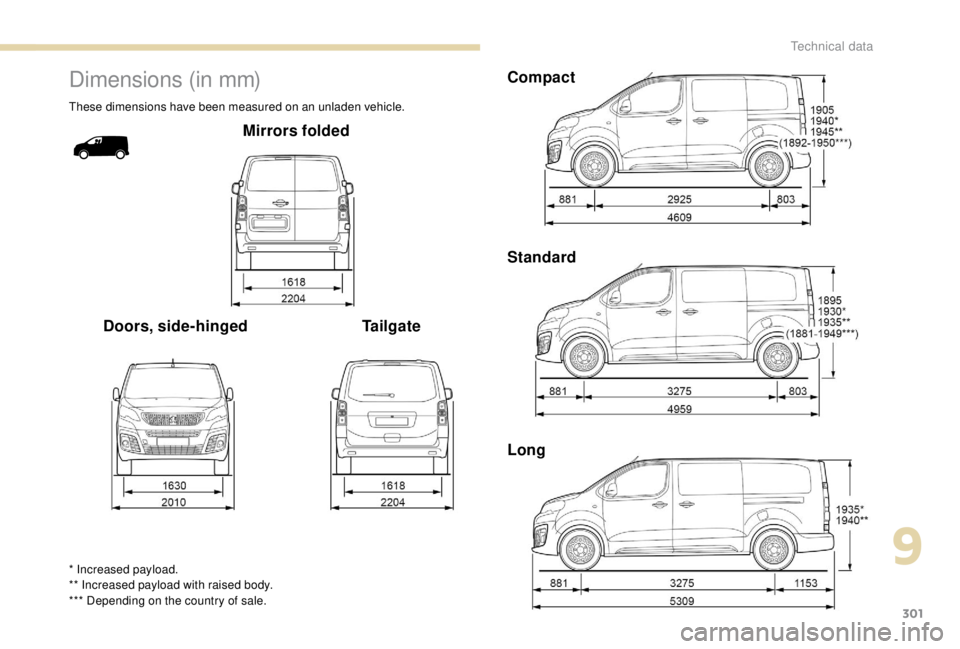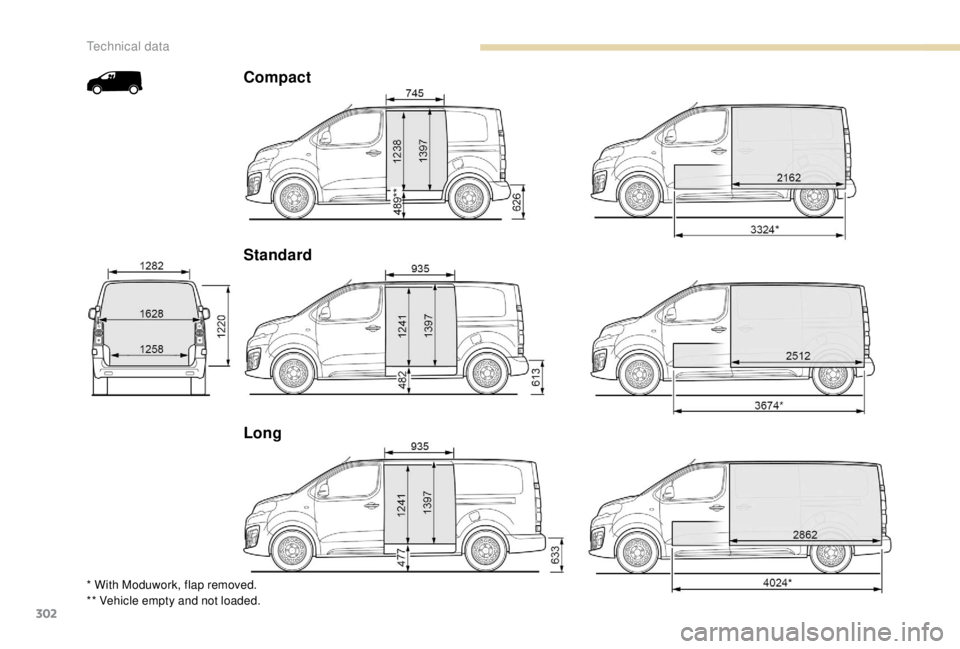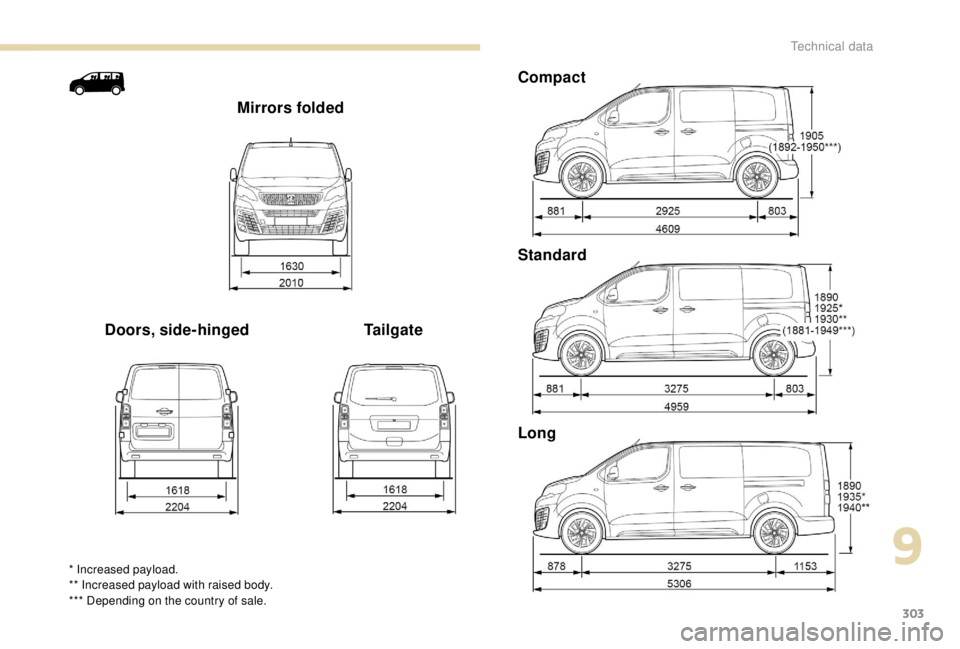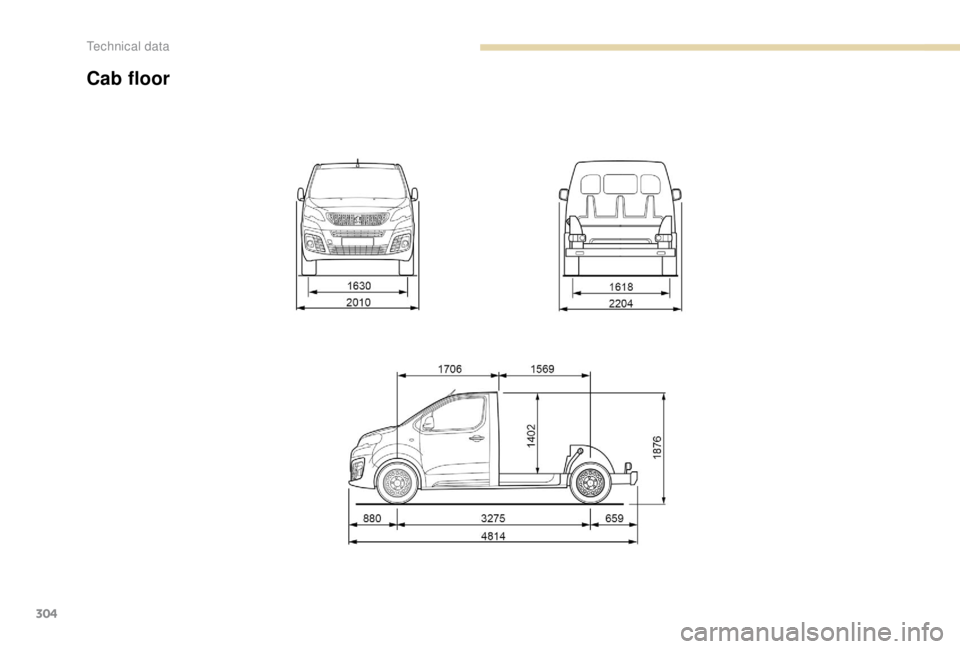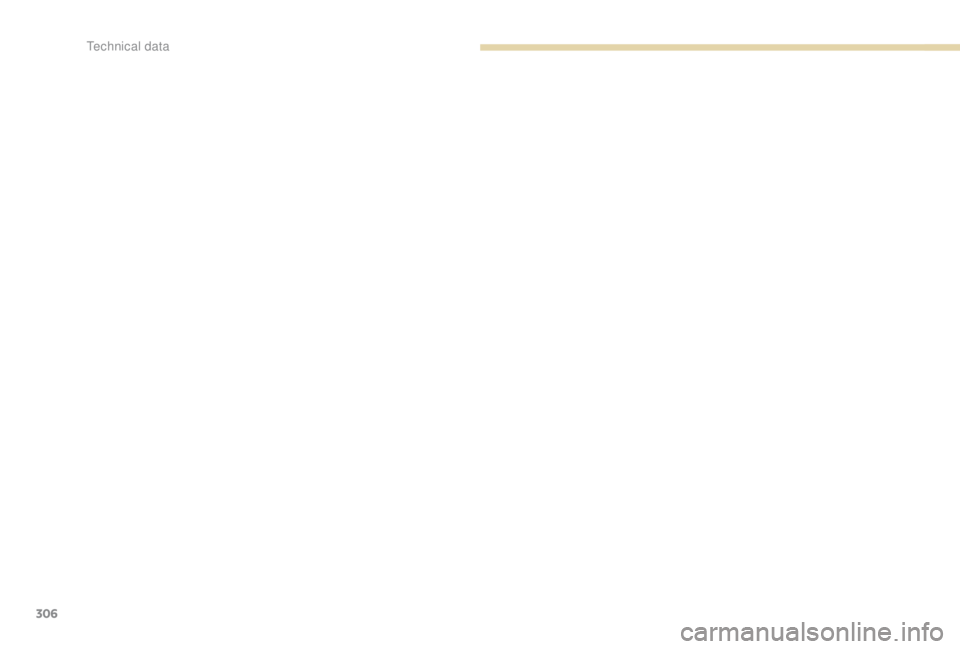PEUGEOT EXPERT 2018 Owners Manual
EXPERT 2018
PEUGEOT
PEUGEOT
https://www.carmanualsonline.info/img/29/77162/w960_77162-0.png
PEUGEOT EXPERT 2018 Owners Manual
Trending: parking brake, engine oil, fuel pressure, tow bar, wheel, steering wheel, maintenance reset
Page 301 of 416
299
Diesel EURO 6.1 engines and towed loads
Engines1.6 litre BlueHDi 95 1.6 litre BlueHDi 95 S&S 1.6 litre BlueHDi 115 S&S
Gearbox Manual 5-speed (BVM5)Electronic 6-speed (ETG6) Manual 6-speed (BVM6)
Code DV6FDUDV6FDU DV6FCU
Regulatory engine type BHVBHSBHX
Length L1, L2, L3L 2 *, L 3 *L1, L2, L3 L 2 *, L 3 *L1, L2, L3 L 2 *, L 3 *
Cubic capacity (cm
3) 1,5 6 0
Max power: CEE standard (kW) 707085
Fuel Diesel
Braked trailer (within
the GTW limit) on a 12%
slope 8
seats 1,8 0 02,000 1,8 0 02,000 1,8 0 02,000
9
seats 1,8 0 02,000 1,8 0 02,000 1,8 0 02,000
Unbraked trailer 8-9
seats 750
Recommended nose
weight (kg)
or
Vertical load 8-9
seats 7280 7280 7280
*
I
ncreased payload.
9
Technical data
Page 302 of 416
300
Engines2 litre BlueHDi 150 S&S2 litre BlueHDi 180 S&S
Gearbox Manual 6-speed (BVM6)Automatic 6-speed (EAT6)
Code DW10FDDW10FC
Regulatory engine type AHXAHH
Length L1, L2, L3L 2 *, L 3 *L1, L2, L3 L 2 *, L 3 *
Cubic capacity (cm
3) 1,9 97
Max power: CEE standard (kW) 90
Fuel Diesel
Braked trailer (within
the GTW limit) on a 12%
slope 8
seats 2,3002,5002,0002,200
9
seats 2,3002,5002,0002,200
Unbraked trailer 8-9
seats 750
Recommended nose
weight (kg)
or
Vertical load 8-9
seats 9210 0 8088
*
I
ncreased payload.
Technical data
Page 303 of 416
301
Dimensions (in mm)
These dimensions have been measured on an unladen vehicle.
Mirrors folded
Doors, side-hinged Tailgate
* Increased payload.
** Increased payload with raised body.
*** Depending on the country of sale.
Compact
Standard
Long
9
Technical data
Page 304 of 416
302
Compact
Standard
Long
* With Moduwork, flap removed.
** Vehicle empty and not loaded.
Technical data
Page 305 of 416
303
Mirrors folded
Doors, side-hinged TailgateCompact
Standard
Long
* Increased payload.
** Increased payload with raised body.
*** Depending on the country of sale.
9
Technical data
Page 306 of 416
304
Cab floor
Technical data
Page 307 of 416
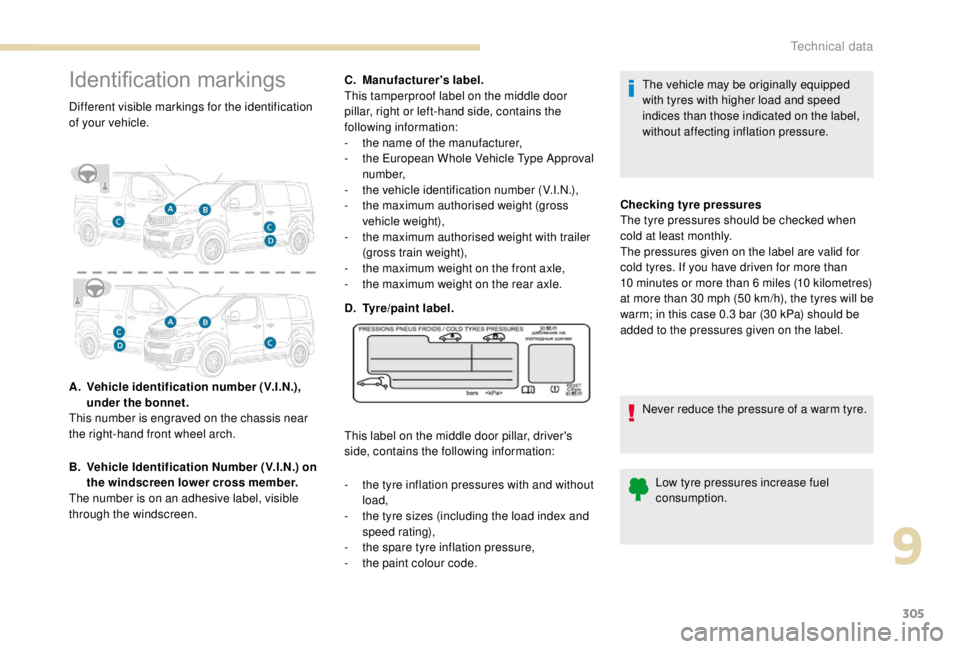
305
Identification markings
Different visible markings for the identification
of your vehicle.
A.
V
ehicle identification number (V.I.N.),
under the bonnet.
This number is engraved on the chassis near
the right-hand front wheel arch.
B.
V
ehicle Identification Number (V.I.N.) on
the windscreen lower cross member.
The number is on an adhesive label, visible
through the windscreen. C.
M
anufacturer's label.
This tamperproof label on the middle door
pillar, right or left-hand side, contains the
following information:
-
t
he name of the manufacturer,
-
t
he European Whole Vehicle Type Approval
number,
-
t
he vehicle identification number (V.I.N.),
-
t
he maximum authorised weight (gross
vehicle weight),
-
t
he maximum authorised weight with trailer
(gross train weight),
-
t
he maximum weight on the front axle,
-
t
he maximum weight on the rear axle.
D.
T
yre/paint label.
This label on the middle door pillar, driver's
side, contains the following information:
-
t
he tyre inflation pressures with and without
load,
-
t
he tyre sizes (including the load index and
speed rating),
-
t
he spare tyre inflation pressure,
-
t
he paint colour code. The vehicle may be originally equipped
with tyres with higher load and speed
indices than those indicated on the label,
without affecting inflation pressure.
Checking tyre pressures
The tyre pressures should be checked when
cold at least monthly.
The pressures given on the label are valid for
cold tyres. If you have driven for more than
10
minutes or more than 6 miles (10 kilometres)
at more than 30
mph (50 km/h), the tyres will be
warm; in this case 0.3
bar (30 kPa) should be
added to the pressures given on the label.
Never reduce the pressure of a warm tyre.Low tyre pressures increase fuel
consumption.
9
Technical data
Page 308 of 416
Page 309 of 416
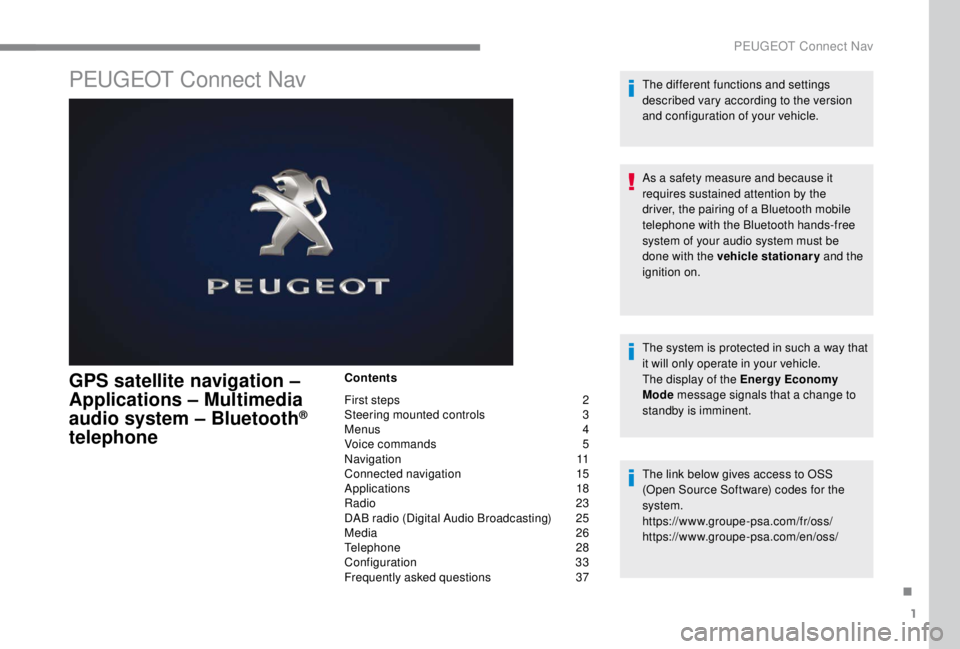
1
PEUGEOT Connect Nav
GPS satellite navigation –
Applications – Multimedia
audio system – Bluetooth
®
telephone
Contents
First steps
2
S
teering mounted controls
3
M
enus
4
V
oice commands
5
N
avigation
1
1
Connected navigation
1
5
Applications
1
8
Radio
2
3
DAB radio (Digital Audio Broadcasting)
2
5
Media
26
T
elephone
2
8
Configuration
3
3
Frequently asked questions
3
7The different functions and settings
described vary according to the version
and configuration of your vehicle.
As a safety measure and because it
requires sustained attention by the
driver, the pairing of a Bluetooth mobile
telephone with the Bluetooth hands-free
system of your audio system must be
done with the vehicle stationary
and the
ignition on.
The system is protected in such a way that
it will only operate in your vehicle.
The display of the Energy Economy
Mode message signals that a change to
standby is imminent.
The link below gives access to OSS
(Open Source Software) codes for the
system.
https://www.groupe-psa.com/fr/oss/
https://www.groupe-psa.com/en/oss/
PEUGEOT Connect Nav
.
PEUGEOT Connect Nav
Page 310 of 416
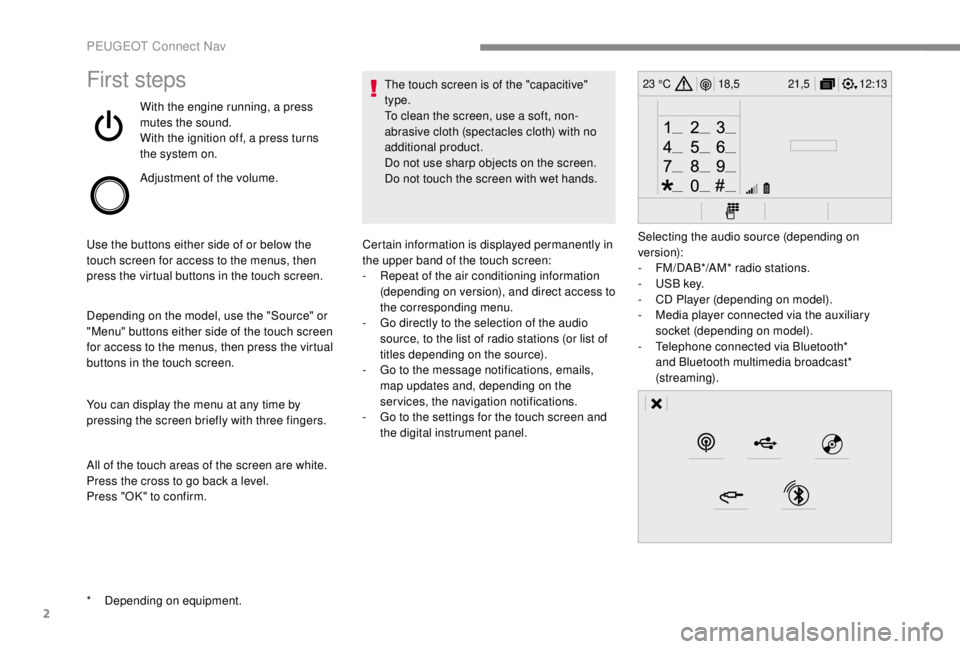
2
12:13
18,5 21,5
23 °CFirst steps
With the engine running, a press
mutes the sound.
With the ignition off, a press turns
the system on.
Adjustment of the volume.
Use the buttons either side of or below the
touch screen for access to the menus, then
press the virtual buttons in the touch screen.
Depending on the model, use the "Source" or
"Menu" buttons either side of the touch screen
for access to the menus, then press the virtual
buttons in the touch screen.
You can display the menu at any time by
pressing the screen briefly with three fingers.
All of the touch areas of the screen are white.
Press the cross to go back a level.
Press "OK" to confirm. The touch screen is of the "capacitive"
type.
To clean the screen, use a soft, non-
abrasive cloth (spectacles cloth) with no
additional product.
Do not use sharp objects on the screen.
Do not touch the screen with wet hands.
*
D
epending on equipment. Certain information is displayed permanently in
the upper band of the touch screen:
-
R
epeat of the air conditioning information
(depending on version), and direct access to
the corresponding menu.
-
G
o directly to the selection of the audio
source, to the list of radio stations (or list of
titles depending on the source).
-
G
o to the message notifications, emails,
map updates and, depending on the
services, the navigation notifications.
-
G
o to the settings for the touch screen and
the digital instrument panel. Selecting the audio source (depending on
version):
-
F
M/DAB*/AM* radio stations.
-
U
SB key.
-
C
D Player (depending on model).
-
M
edia player connected via the auxiliary
socket (depending on model).
-
T
elephone connected via Bluetooth*
and Bluetooth multimedia broadcast*
(streaming).
PEUGEOT Connect Nav
Trending: coolant reservoir, ECO mode, engine, child lock, battery location, alternator belt, headlamp
